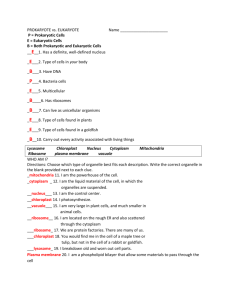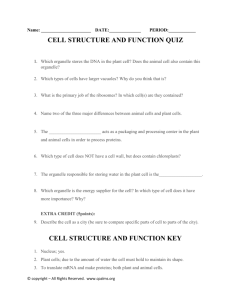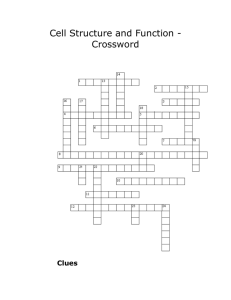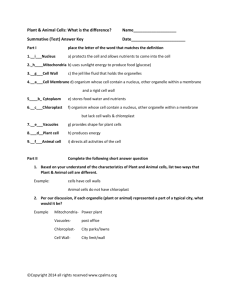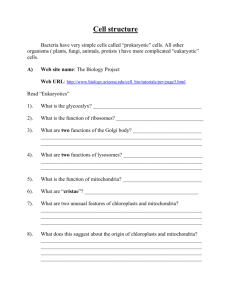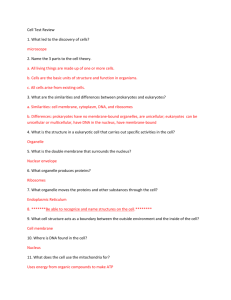CELLS AND BODY SYSTEMS
advertisement
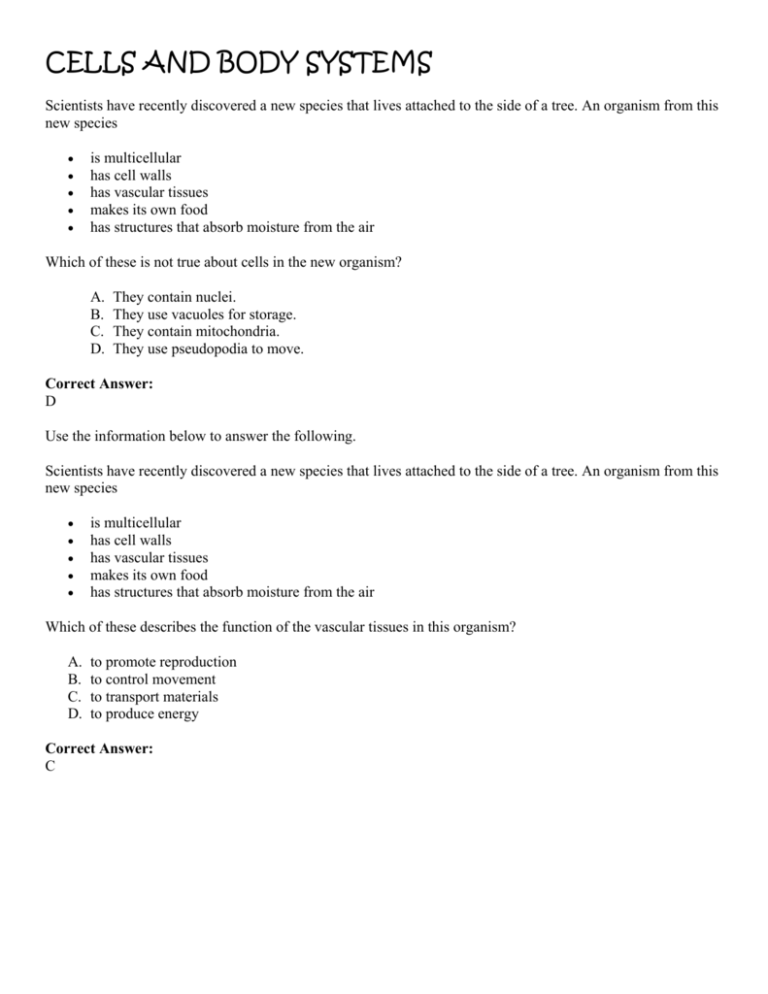
CELLS AND BODY SYSTEMS Scientists have recently discovered a new species that lives attached to the side of a tree. An organism from this new species is multicellular has cell walls has vascular tissues makes its own food has structures that absorb moisture from the air Which of these is not true about cells in the new organism? A. B. C. D. They contain nuclei. They use vacuoles for storage. They contain mitochondria. They use pseudopodia to move. Correct Answer: D Use the information below to answer the following. Scientists have recently discovered a new species that lives attached to the side of a tree. An organism from this new species is multicellular has cell walls has vascular tissues makes its own food has structures that absorb moisture from the air Which of these describes the function of the vascular tissues in this organism? A. B. C. D. to promote reproduction to control movement to transport materials to produce energy Correct Answer: C A group of students studied the effect of light intensity on the rate of a cell process in Elodea plants. The students exposed Elodea plants to different light intensities. A gas was produced by the cell process. The amount of this gas was measured. The rate of the cell process was determined by the amount of gas produced. A graph of the students' measurements is shown below. Which of these parts of the Elodea plant cell produces the gas measured in the experiment? A. B. C. D. mitochondrion chloroplast ribosome nucleus Correct Answer: B A student observed different types of cells under a microscope. Four of the cells he observed are shown below. Which of these structures in Cell 3 releases energy for use in cell processes? A. B. C. D. nucleus cell wall chloroplast mitochondrion Correct Answer: D Use the information and the diagrams below to answer the following. A student observed different types of cells under a microscope. Four of the cells he observed are shown below. Cell 4 has many hair-like structures that it uses for movement. What are these structures called? A. B. C. D. cilia flagella vacuoles pseudopodia Correct Answer: A Which of these body systems transports glucose and other substances in the blood to the cells of the body? A. B. C. D. digestive system endocrine system circulatory system reproductive system Correct Answer: C Maryland white oak trees make their own food. Their cells contain structures that capture energy from the sun. What are these structures? A. B. C. D. chloroplasts nuclei mitochondria ribosomes Correct Answer: A The diagram below shows the key steps for making proteins. Which step involves ribosomes? A. B. C. D. I II III IV Correct Answer: D During a trip to the beach, Allen finds a colony of sea anemones on a rock. These sea anemones are green and get their color from tiny single-celled algae that live in their tissues. The algae produce food for the anemones while the anemones provide a place for the algae to live. A drawing of a mobile form of the single-celled green algae is shown below. Which of these structures help this algae move? A. B. C. D. flagella cilia pseudopodia vacuoles Correct Answer: A Which parts of the single-celled algae are responsible for capturing energy? A. B. C. D. nuclei chloroplasts mitochondria cytoplasm Correct Answer: B Most organisms need oxygen for their cells to function normally. Which of these organelles use oxygen to release energy? A. B. C. D. nuclei ribosomes chloroplasts mitochondria Correct Answer: D A student observes a unicellular organism under a microscope. After a while, the organism begins to split into two cells, as shown in the diagram. Which of these structures does the organism shown above use to move itself? A. B. C. D. cilia nuclei flagella ribosomes Correct Answer: A Which cell structure contains molecules that direct cell activities? A. B. C. D. nucleus ribosome mitochondrion chloroplast Correct Answer: A Use the information and the diagram below to answer the following question. Part of the process of protein synthesis is shown below. The different structures in this process are numbered 1 through 5. Structure 2 in the diagram represents a A. B. C. D. ribosome mitochondrion protein chloroplast Correct Answer: A The process shown in the diagram occurs in the A. B. C. D. nucleus cytoplasm vacuole chromosome Correct Answer: B Structure 1 is produced in what part of the cell? A. B. C. D. vacuole cytoplasm mitochondria nucleus Correct Answer: D Some cells have many short, hairlike structures on their surfaces. These structures are used mainly for A. B. C. D. cell movement DNA replication energy production waste removal Correct Answer: A Use the information following to answer the following question. A particular toxin prevents cellular production of usable energy. Cells that are affected by this toxin are unable to carry out many of their normal functions. Which of these organelles would be most directly harmed by this toxin? A. B. C. D. ribosomes the nucleus mitochondria the vacuole Correct Answer: C Use the information and diagram below to answer the following item. Animal cells contain an organelle that helps release energy. A diagram of this organelle is shown below. What is the organelle described? A. B. C. D. chloroplast mitochondrion nucleus ribosome Correct Answer: B Use the information and diagram below to answer the following item. Animal cells contain an organelle that helps release energy. A diagram of this organelle is shown below. Which function would the energy-releasing organelle most likely have in the animal cell? A. B. C. D. cellular control cellular respiration removal of wastes storage of nutrients Correct Answer: B Use the information and the diagram below to answer the following item. Arteriosclerosis is a disease which clogs arteries in the human body. In arteriosclerosis, artery walls become thick. Fatty deposits build up on inner walls of arteries. This condition reduces the ability of arteries to perform their function. The diagram below shows a comparison between a healthy artery and one with arteriosclerosis. Which body function is most affected by arteriosclerosis? A. B. C. D. circulating blood to tissues assembling amino acids into proteins replacing damaged cells with new cells breaking down food particles into molecules Correct Answer: A A healthy circulatory system is able to deliver oxygen and nutrients to cells. Which cell organelle requires oxygen to carry out cellular respiration? A. B. C. D. ribosomes nuclei mitochondrion membranes Correct Answer: C Use the information below to answer the following item. Plants grow in various environments. Some plants, like mangroves, grow in salty wetlands. Mangroves have specialized structures that prevent salt from entering their cells. Other mangroves have specialized glands that can excrete excess salt. Which organelle in mangrove cells converts solar energy into useable energy? A. B. C. D. nucleus ribosome chloroplast mitochondrion Correct Answer: C

